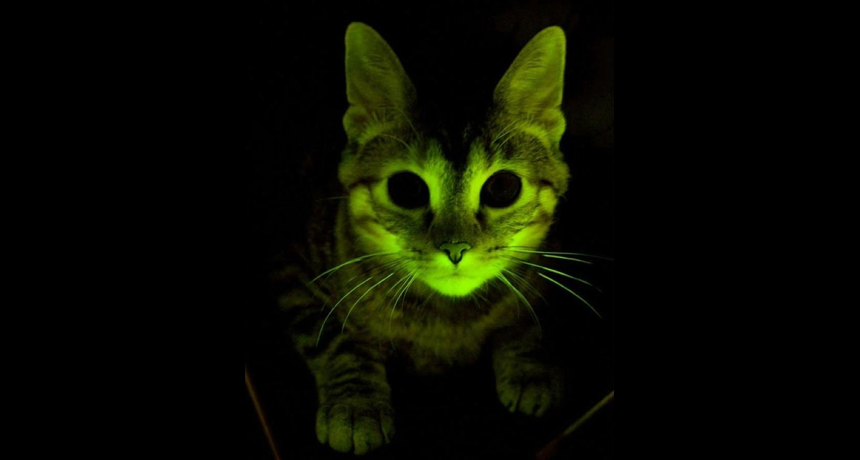Glow kitties
Cats light up when an experiment is successful

A cat bioengineered to glow.
Mayo Clinic
Just in time for Halloween, a team of scientists has introduced a new breed of kittens that glow in the dark. They’re cute, cuddly and bright, with fur that shines yellow-green when you turn off the light. But like the bag you carry around for trick-or-treating, it’s what’s inside these cats that counts. The researchers are testing a way to fight a disease that infects cats all over the world, and the kittens’ spooky glow shows that the test is working.
The disease is called Feline Immunodeficiency Virus, or FIV. Of every 100 cats in the United States, between one and three have the virus. It’s most often transmitted when one cat bites another, and over time the disease can cause a cat to get sick. Many scientists study FIV because it’s similar to a virus called HIV, short for human immunodeficiency virus, which infects people. An HIV infection can lead to a fatal syndrome called AIDS. The body of a person with AIDS is unable to fight off infections. Since AIDS was discovered 30 years ago, 30 million people have died from the disease.
Because HIV and FIV are similar, scientists suspect that if they find a way to fight FIV, they might discover a way to help people with HIV.
Eric Poeschla led the study on glowing kittens. He is a molecular virologist at the Mayo Clinic College of Medicine in Rochester, Minn. Virologists study viruses, and molecular virologists study the tiny body of a virus itself. They want to understand how such a small thing can do so much harm.
A virus (like FIV or HIV) is a tiny particle that finds and attacks cells in the body. It has a set of instructions, called genes, for how to reproduce. A virus’s only job is to make more of itself, and it can reproduce only if it attacks and invades cells. When a virus attacks a cell, it injects its genes inside, and the hijacked cell then creates new virus particles. The new particles then go attack other cells.
Poeschla and his colleagues know that FIV can be stopped — but so far, only in rhesus monkeys. Rhesus monkeys can fight off the infection because their cells contain a special protein that cats’ don’t. Proteins are the workers inside a cell, and each protein has its own to-do list. One of the jobs of the special monkey protein is to stop viral infections. The scientists reasoned that if cats had this protein, FIV wouldn’t be able to infect felines.
A cell’s genes contain the recipes for all the proteins it needs. So Poeschla and his team injected feline egg cells with the gene that contained instructions to make the monkey protein. They weren’t sure the gene would be adopted by the egg cells, so they injected a second gene along with the first. This second gene contained instructions for making a cat’s fur glow in the dark. If the cats glowed, the scientists would know the experiment was working.
Poeschla’s team then implanted the gene-modified eggs in a cat; the cat later gave birth to three kittens. When Poeschla and his team saw that the kittens glowed in the dark, they knew the genes were at work in the cells. Other scientists have engineered cats that glow in the dark before, but this experiment is the first time scientists have added two new genes to a cat’s DNA.
Even though they were able to add the monkey protein–forming gene to the cats’ cells, Poeschla and his colleagues still don’t know if the animals can now fight off FIV. They’ll need to breed more cats with the gene, and test these animals to see if they’re immune to FIV.
And if the new cats are immune to FIV, the scientists hope they might learn something new about how proteins can be used to prevent HIV infection.
POWER WORDS (adapted from the New Oxford American Dictionary)
gene A sequence of DNA that determines a particular characteristic in an organism. Genes are passed from parents to children, and genes contain the instructions for building proteins.
DNA, or deoxyribonucleic acid A long, spiral-shaped molecule inside nearly every cell of an organism that carries genetic information. Chromosomes are made of DNA.
protein Compounds that are an essential part of all living organisms. Proteins do the work inside a cell. They may be parts of body tissues such as muscle, hair and collagen. Proteins may also be enzymes and antibodies.
virus A tiny particle that can cause infection and is typically made of DNA inside a protein coat. A virus is too small to be seen by microscopes, and it is able to multiply only within the living cells of a host.
molecule A group of atoms bonded together.







